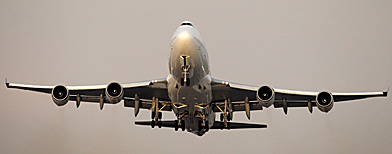 The growing number of aircraft near-misses in US skies is making civilian aviation authorities increasingly concerned and has prompted them to reexamine air traffic control procedures.
The growing number of aircraft near-misses in US skies is making civilian aviation authorities increasingly concerned and has prompted them to reexamine air traffic control procedures.
“Over the last weeks there have been a number of instances where separation was lost between aircraft and in some cases there was a bit of a delay of notification that obviously caused some concern,” Federal Aviation Administration spokesman Lynn Lunsford told AFP.
He said that all these incidents, the latest of which occurred just on May 21, remain under investigation.
“Anytime you lose the required separation between aircraft, it’s unacceptable, and we work to figure out what happen and what we can do to prevent similar ones,” Lunsford pointed out.
More than half a dozen extreme near-misses have been reported by the FAA over the past two months, prompting the National Transportation Safety Board to launch an inquiry.
On Friday, the NTSB reported that an Airbus A319 passenger jet and a Boeing 747-400 cargo plane had been involved in an incident over Alaska a week ago.
The board said the Airbus, US Airways Flight 140, was carrying 138 passengers and crew and the cargo plane a crew of two when they “came within an estimated 100 feet (30 meters) vertically and a .33-mile (530-meter) lateral separation.”
The May 21 incident occurred at night near Anchorage International Airport as the cargo plane took off for Chicago and the US Airways flight was coming in for a landing from Phoenix, Arizona, the NTSB said in a statement.
The Airbus pilots scrapped their initial landing attempt due to tailwinds and after requesting new landing instructions from the control tower, were told to turn right and report back when they saw the 747 departing.
Once the cargo plane was sighted, the Airbus was told to “maintain visual separation,” climb to 3,000 feet (910 meters) and turn right.
But the Airbus pilots refused to obey “because the turn would have put their flight in direct conflict with the B747,” the NTSB said.
Instructed to “monitor vertical speed” for a descent, the Airbus began dropping in altitude and lost sight of the B747.
At 1,500 feet the plane’s Traffic Alert and Collision Avoidance System bellowed out a verbal warning: “traffic, traffic.”
“There were no reported injuries or damage to either aircraft,” the NTSB said, adding that a board investigator was heading to Anchorage to investigate the incident.
In late March, a Boeing 777 operated by United Airlines that took off from San Francisco airport with 268 passengers came within just 60 meters of a small single-engine plane.
A month later, two similar incidents occurred at Hobby Airport in Houston. The first involved a helicopter and a Southwest Airlines jet, the second a small tourist plane and another Southwest carrier.
Two other collisions were narrowly avoided at an airport in Burbank, California, earlier this month.
FAA administrator Randy Babitt recently brought together a group of experts to study the problem and come up with a solution.
Normally, these incidents have to be reported to the FAA within 24 hours, but in some cases the agency had not been notified for several days.
According to The Wall Street Journal, this situation has infuriated FAA authorities, and they have made their feelings known to air traffic controllers across the United States.
